Drop Nozzle from a Remotely Piloted Aerial Application System Reduces Spray Displacement
Abstract
1. Introduction
2. Materials and Methods
2.1. Take-Off and Landing with the Drop Nozzle
2.2. Determination of Spray Displacement
2.3. Determination of Spray Droplet Characteristics
3. Results
3.1. Spray Droplet Spectra
3.2. Spray Displacement Analysis
3.3. Comparisons with Overall Average Decision Chart
4. Discussion
5. Conclusions
Author Contributions
Funding
Data Availability Statement
Conflicts of Interest
References
- Soltani, N.; Dille, J.A.; Burke, I.C.; Everman, W.J.; VanGessel, M.J.; Davis, V.M.; Sikkema, P.H. Potential corn yield losses from weeds in North America. Weed Technol. 2016, 30, 979–984. [Google Scholar] [CrossRef]
- James, T.; Rahman, A.; Mellsop, J. Weed competition in maize crop under different timings for postemergence weed control. N. Z. Plant Prot. 2000, 53, 269–272. Available online: http://www.nzpps.org/terms_of_use.html (accessed on 10 December 2024). [CrossRef]
- Sardana, V.; Mahajan, G.; Jabran, K.; Chauhan, B.S. Role of competition in managing weeds: An introduction to the special issue. Crop Protect. 2017, 95, 1–7. [Google Scholar] [CrossRef]
- Fernando, N.; Manalil, S.; Florentine, S.K.; Chauhan, B.S.; Seneweera, S. Glyphosate resistance of C3 and C4 weeds under rising atmospheric CO2. Front. Plant Sci. 2016, 7, 910. [Google Scholar] [CrossRef] [PubMed]
- Kaur, R.; Kumar, S.; Ali, S.; Kumar, S.; Ezing, U.; Bana, R.; Meena, S.; Dass, A.; Singh, T. Impacts of climate change on crop-weed dynamics: Challenges and strategies for weed management in a changing climate. J. Environ. Biol. 2024, 9, 015–021. [Google Scholar]
- Amare, T. Review on impact of climate change on weed and their management. Amer. J. Biol. Environ. Stat. 2016, 2, 21–27. [Google Scholar] [CrossRef]
- Baldwin, F.L. Transgenic crops: A view from the US Extension Service. Pest Manag. Sci. 2000, 56, 584–585. [Google Scholar] [CrossRef]
- Johnson, G.A.; Mortensen, D.A.; Gotway, C.A. Spatial and temporal analysis of weed seedling populations using geostatistics. Weed Sci. 1996, 44, 704–710. [Google Scholar] [CrossRef]
- Nobre, F.L.d.L.; Santos, R.F.; Herrera, J.L.; Araújo, A.L.d.; Johann, J.A.; Gurgacz, F.; Siqueira, J.A.C.; Prior, M. Use of drones in herbicide spot spraying: A systematic review. Adv. Weed Sci. 2024, 41, e020230014. [Google Scholar] [CrossRef]
- Sétamou, M.; Bartels, D.W. Living on the edges: Spatial niche occupation of Asian citrus psyllid, Diaphorina citri Kuwayama (Hemiptera: Liviidae), in citrus groves. PLoS ONE 2015, 10, e0131917. [Google Scholar] [CrossRef] [PubMed]
- Severtson, D.; Flower, K.; Nansen, C. Nonrandom distribution of cabbage aphids (Hemiptera: Aphididae) in dryland canola (Brassicales: Brassicaceae). Environ. Entomol. 2015, 44, 767–779. [Google Scholar] [CrossRef] [PubMed]
- Nguyen, H.D.D.; Nansen, C. Edge-biased distributions of insects. A review. Agron. Sustain. Dev. 2018, 38, 11. [Google Scholar] [CrossRef]
- Mattson, W.J.; Haack, R.A. The role of drought in outbreaks of plant-eating insects. Bioscience 1987, 37, 110–118. Available online: https://www.jstor.org/stable/1310365 (accessed on 10 December 2024). [CrossRef]
- Walter, A.J.; Difonzo, C.D. Soil potassium deficiency affects soybean phloem nitrogen and soybean aphid populations. Environ. Entomol. 2014, 36, 26–33. [Google Scholar] [CrossRef]
- West, K.; Nansen, C. Smart-use of fertilizers to manage spider mites (Acari: Tetrachynidae) and other arthropod pests. Plant Sci. Today 2014, 1, 161–164. [Google Scholar] [CrossRef][Green Version]
- Lillesand, T.; Kiefer, R.W.; Chipman, J. Remote Sensing and Image Interpretation; John Wiley & Sons: Hoboken, NJ, USA, 2015. [Google Scholar]
- Torres-Sánchez, J.; López-Granados, F.; De Castro, A.I.; Peña-Barragán, J.M. Configuration and specifications of an unmanned aerial vehicle (UAV) for early site specific weed management. PLoS ONE 2013, 8, e58210. [Google Scholar] [CrossRef]
- Abbasi, R.; Martinez, P.; Ahmad, R. The digitization of agricultural industry—A systematic literature review on agriculture 4.0. Smart Agric. Technol. 2022, 2, 100042. [Google Scholar] [CrossRef]
- Hunter III, J.E.; Gannon, T.W.; Richardson, R.J.; Yelverton, F.H.; Leon, R.G. Integration of remote-weed mapping and an autonomous spraying unmanned aerial vehicle for site-specific weed management. Pest Manag. Sci. 2020, 76, 1386–1392. [Google Scholar] [CrossRef]
- Zhang, C.; Kovacs, J.M. The application of small unmanned aerial systems for precision agriculture: A review. Precis. Agric. 2012, 13, 693–712. [Google Scholar] [CrossRef]
- Xiang, H.; Tian, L. Development of a low-cost agricultural remote sensing system based on an autonomous unmanned aerial vehicle (UAV). Biosys. Eng. 2011, 108, 174–190. [Google Scholar] [CrossRef]
- Allmendinger, A.; Spaeth, M.; Saile, M.; Peteinatos, G.G.; Gerhards, R. Agronomic and Technical Evaluation of Herbicide Spot Spraying in Maize Based on High-Resolution Aerial Weed Maps—An On-Farm Trial. Plants 2024, 13, 2164. [Google Scholar] [CrossRef]
- Richardson, B.; Rolando, C.A.; Kimberley, M.O. Quantifying spray deposition from a UAV configured for spot spray applications to individual plants. Trans. ASABE 2020, 63, 1049–1058. [Google Scholar] [CrossRef]
- Singh, V.; Rana, A.; Bishop, M.; Filippi, A.M.; Cope, D.; Rajan, N.; Bagavathiannan, M. Unmanned aircraft systems for precision weed detection and management: Prospects and challenges. Adv. Agron. 2020, 159, 93–134. [Google Scholar] [CrossRef]
- Roslim, M.H.M.; Juraimi, A.S.; Che’Ya, N.N.; Sulaiman, N.; Manaf, M.N.H.A.; Ramli, Z.; Motmainna, M. Using remote sensing and an unmanned aerial system for weed management in agricultural crops: A review. Agronomy 2021, 11, 1809. [Google Scholar] [CrossRef]
- Ghatrehsamani, S.; Jha, G.; Dutta, W.; Molaei, F.; Nazrul, F.; Fortin, M.; Bansal, S.; Debangshi, U.; Neupane, J. Artificial intelligence tools and techniques to combat herbicide resistant weeds—A review. Sustainability 2023, 15, 1843. [Google Scholar] [CrossRef]
- Delbert, C. This Badass Robot Uses Lasers to Slay 100,000 Weeds per Hour. 2021. Available online: https://www.popularmechanics.com/technology/robots/a36331690/autonomous-farming-robot-kills-weeds/ (accessed on 6 January 2025).
- Bradley, K. Weed Electrocution Research Sparks Interest as Herbicide Resistance Impedes Current Methods. 2021. Available online: https://extension.missouri.edu/news/weed-electrocution-research-sparks-interest-as-herbicide-resistance-impedes-current-methods (accessed on 6 January 2025).
- Python Software Foundation. Anaconda Software, Version 2-2.4.0; Python Software Foundation: Wilmington, DE, USA, 2024.
- ASABE. Spray Nozzle Classification by Droplet Spectra; ANSI/ASAE S572.3; ASABE: St. Joseph, MI, USA, 2020. [Google Scholar]
- SAS. JMP® 14; SAS Institute Inc.: Cary, NC, USA, 2018. [Google Scholar]
- Snedecor, G.W.; Cochran, W.G. Statistical Methods, 6th ed.; The Iowa State University Press: Ames, IA, USA, 1967; p. 593. [Google Scholar]
- SAS Institute. SAS/QC® 14.1 User’s Guide The ANOM Procedure; 14.1; SAS Institute Inc.: Cary, NC, USA, 2015. [Google Scholar]
- Zhou, X.; Roberts, R.K.; Larson, J.A.; Lambert, D.M.; English, B.C.; Mishra, A.K.; Falconer, L.L.; Hogan Jr, R.J.; Johnson, J.L.; Reeves, J.M. Differences in glyphosate-resistant weed management practices over time and regions. Weed Technol. 2016, 30, 1–12. [Google Scholar] [CrossRef]
- Unan, R.; Galvin, L.; Becerra-Alvarez, A.; Al-Khatib, K. Assessing clethodim spot spraying applications for control of problematic weedy rice and other grasses in California rice fields. Agron. J. 2024, 116, 302–312. [Google Scholar] [CrossRef]
- Bautista, A.S.; Tarrazó-Serrano, D.; Uris, A.; Blesa, M.; Estruch-Guitart, V.; Castiñeira-Ibáñez, S.; Rubio, C. Remote Sensing Evaluation Drone Herbicide Application Effectiveness for Controlling Echinochloa spp. in Rice Crop in Valencia (Spain). Sensors 2024, 24, 804. [Google Scholar] [CrossRef] [PubMed]
- Allmendinger, A.; Spaeth, M.; Saile, M.; Peteinatos, G.G.; Gerhards, R. Precision chemical weed management strategies: A review and a design of a new CNN-based modular spot sprayer. Agronomy 2022, 12, 1620. [Google Scholar] [CrossRef]
- Hunter, J.E., III. Integration of Unmanned Aerial Vehicles (UAVs) for Remote Sensing and Spray Applications for Weed Management. Ph.D. Thesis, North Carolina State University, Raleigh, NC, USA, 2019. [Google Scholar]
- Prokop, M. Leaves coverage of spray liquid and influence on herbicide efficacy. Acta Univ. Agric. Silvic. Mendel. Brun. 2009, 57, 263–270. [Google Scholar] [CrossRef]
- Coombes, M.; Newton, S.; Knowles, J.; Garmory, A. The influence of rotor downwash on spray distribution under a quadrotor unmanned aerial system. Comput. Electron. Agric. 2022, 196, 106807. [Google Scholar] [CrossRef]
- Zhang, H.; Lan, Y.; Shen, N.; Wu, J.; Wang, T.; Han, J.; Wen, S. Numerical analysis of downwash flow field from quad-rotor unmanned aerial vehicles. Inter. J. Precis. Agric. Aviat. 2020, 3, 1–7. [Google Scholar] [CrossRef]
- Yang, Z.; Qi, L.; Wu, Y. Influence of UAV Rotor Down-wash Airflow For Droplet Penetration. In Proceedings of the 2018 ASABE Annual International Meeting, Detroit, MI, USA, 29 July–1 August 2018. [Google Scholar] [CrossRef]
- Tan, Y.; Chen, J.; Norton, T.; Wang, J.; Liu, X.; Yang, S.; Zheng, Y. The computational fluid dynamic modeling of downwash flow field for a six-rotor UAV. Front. Agric. Sci. Eng. 2018, 5, 159–167. [Google Scholar] [CrossRef]
- Azghadi, M.R.; Olsen, A.; Wood, J.; Saleh, A.; Calvert, B.; Granshaw, T.; Fillols, E.; Philippa, B. Precise robotic weed spot-spraying for reduced herbicide usage and improved environmental outcomes—A real-world case study. arXiv 2024, arXiv:2401.13931. [Google Scholar] [CrossRef]
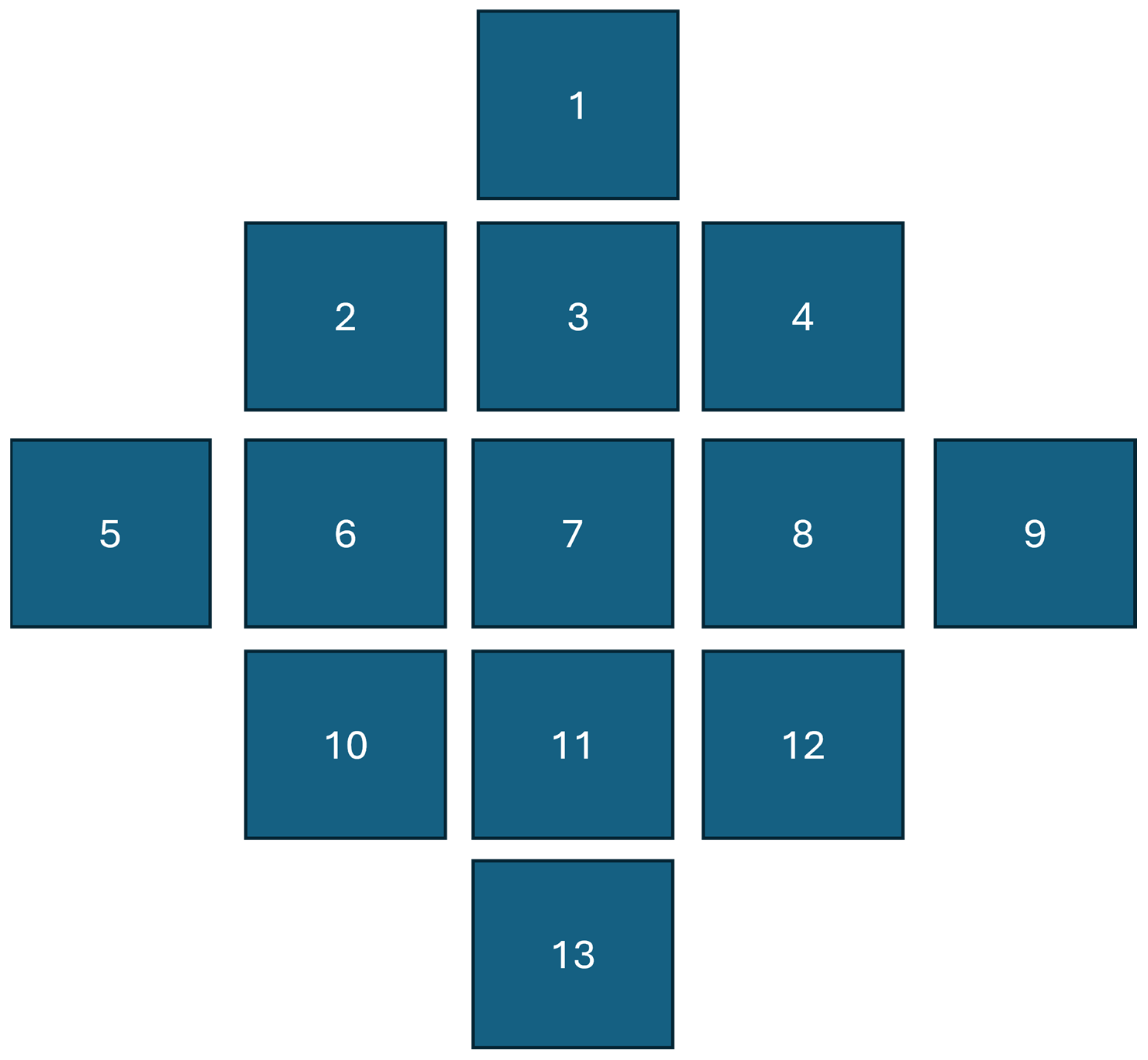




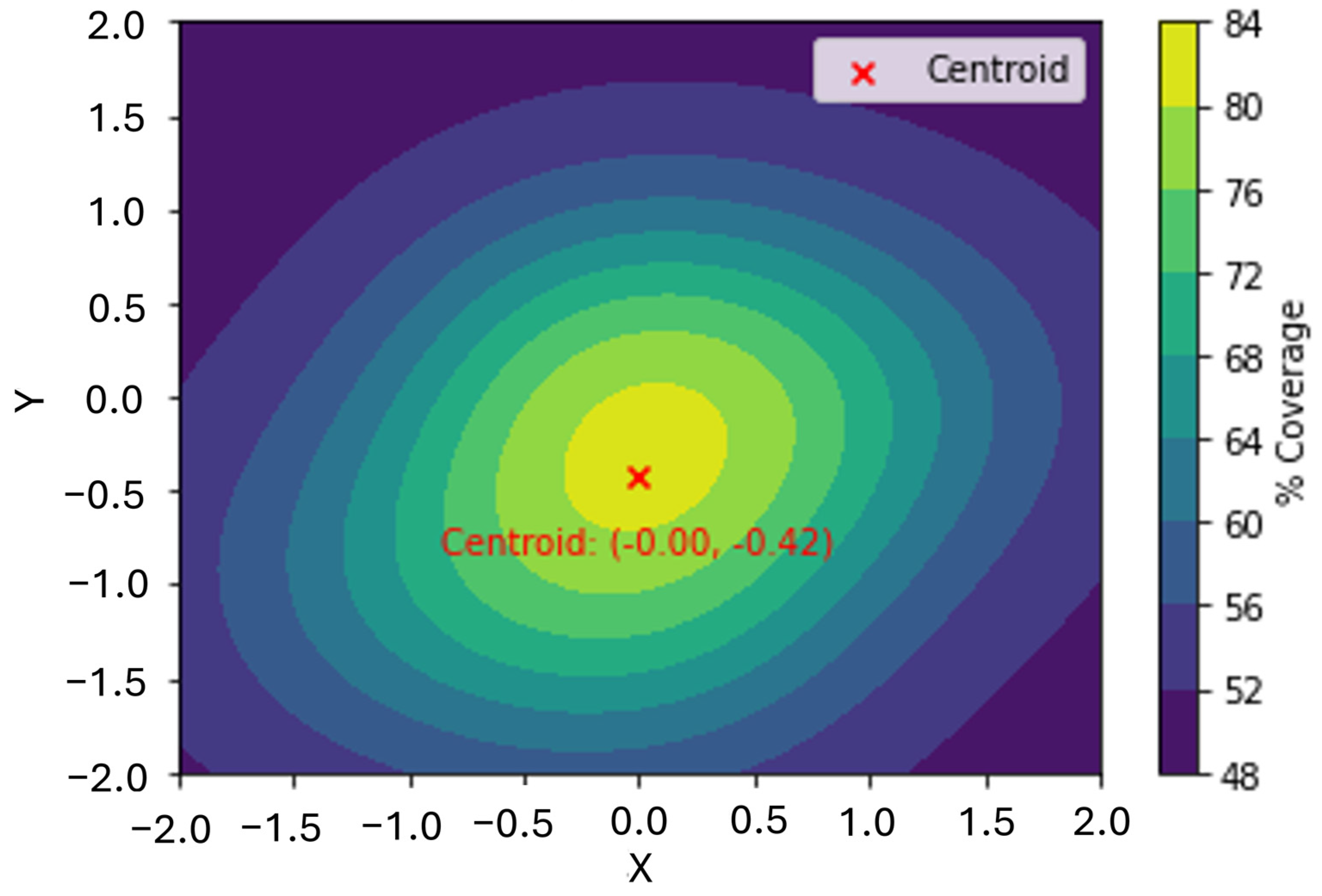

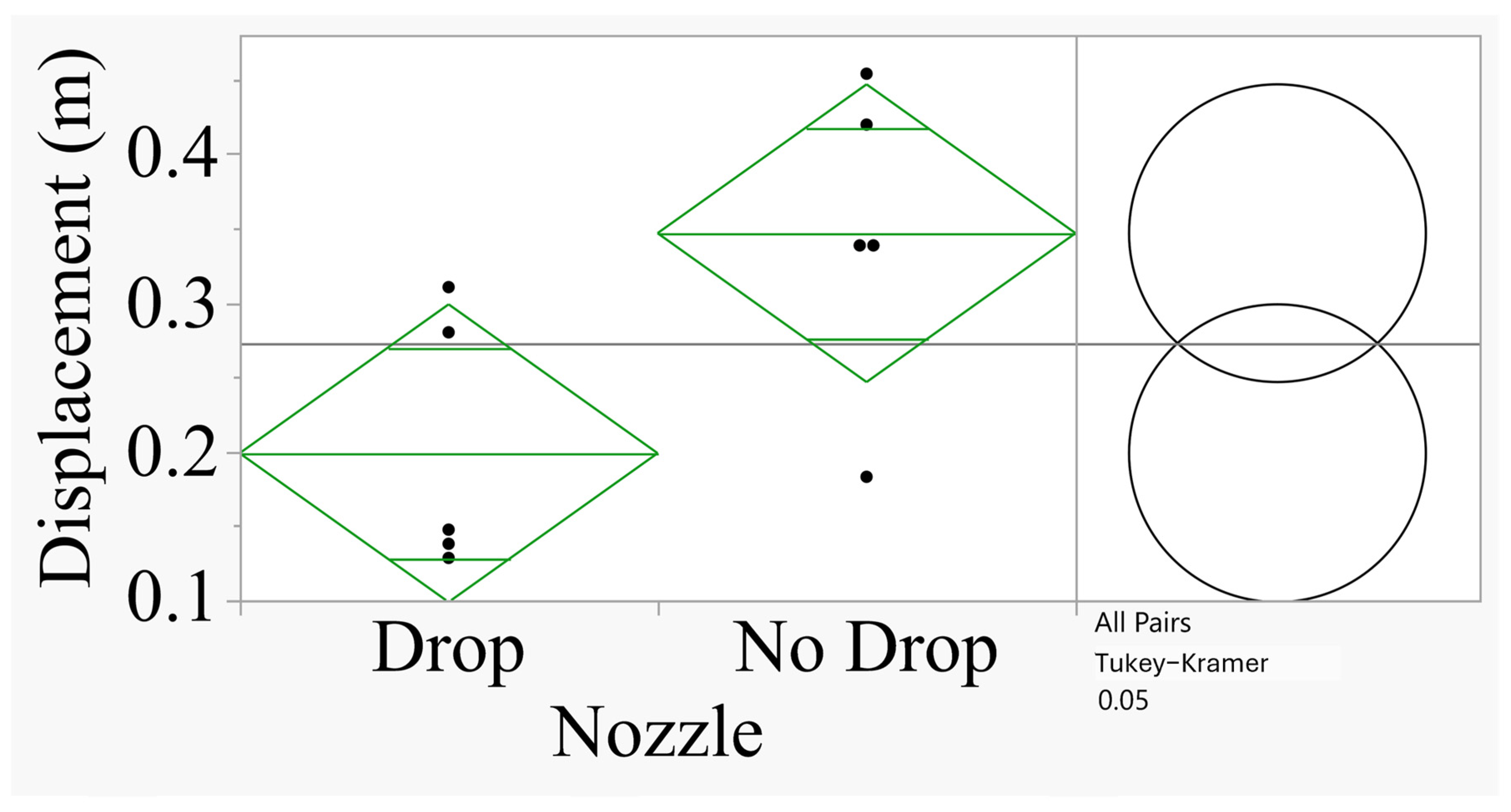


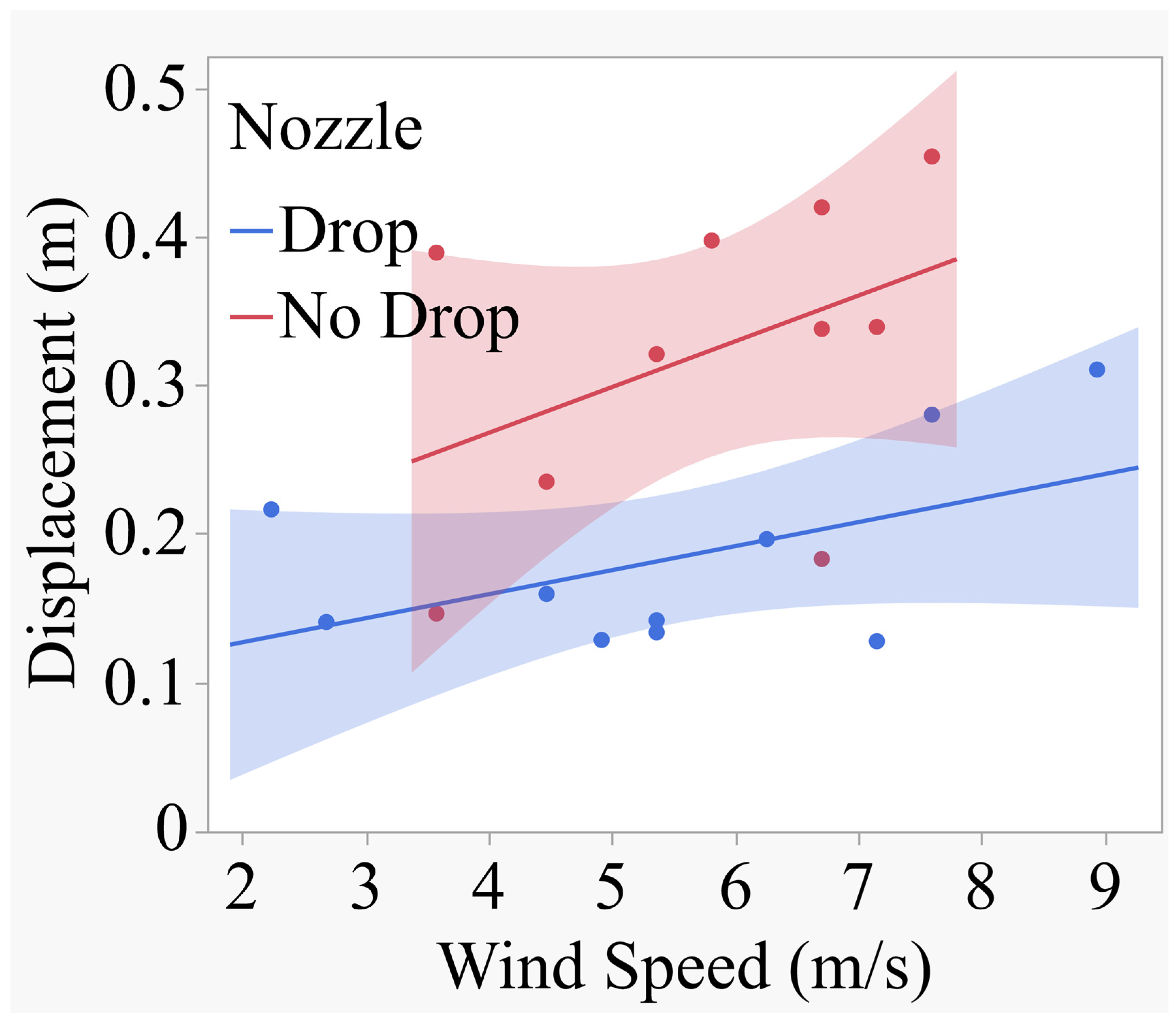
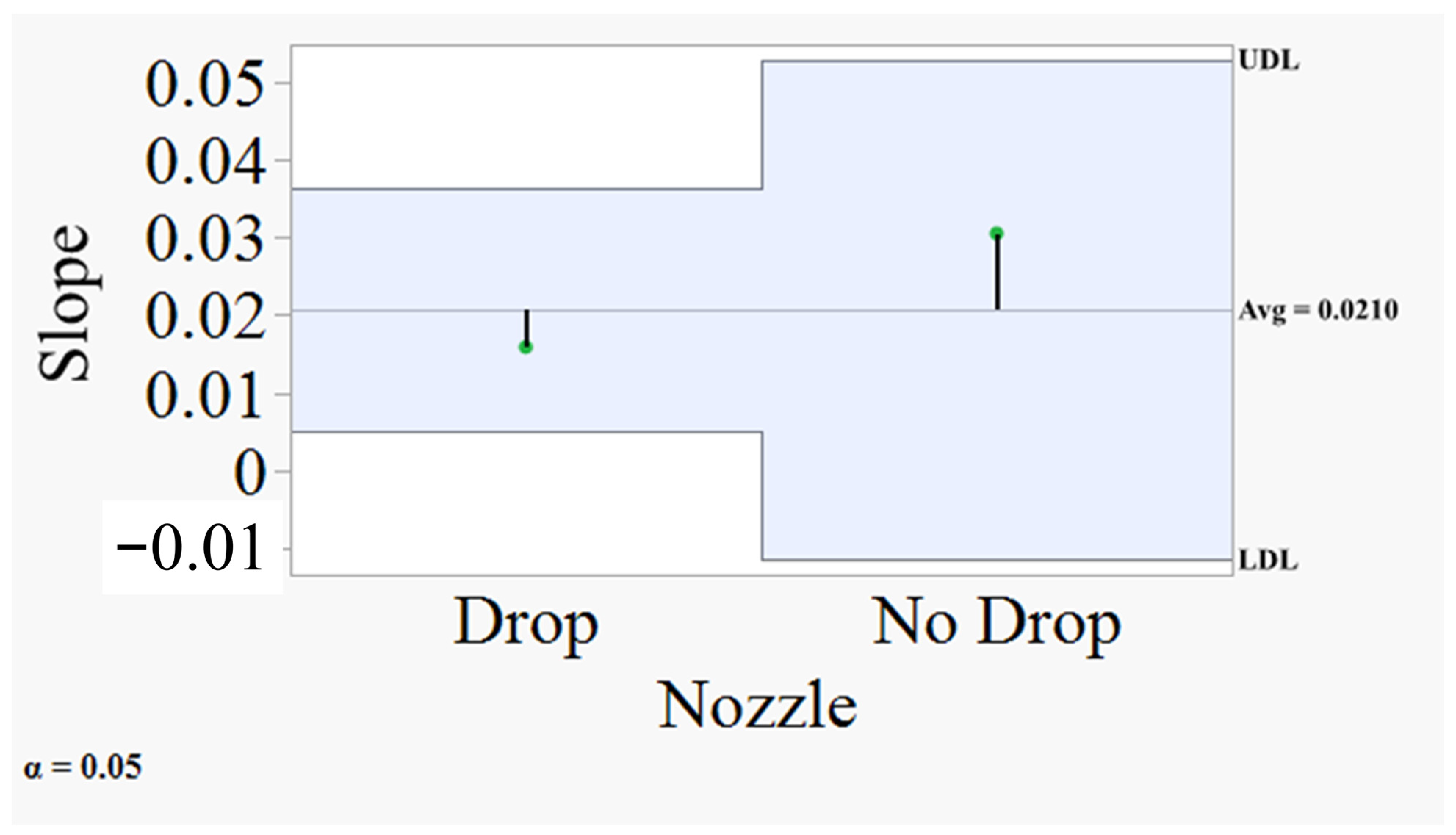

| Treatment | Angle | Drop | Replication |
|---|---|---|---|
| 1 | 0 | No Drop | 1 |
| 1 | 0 | No Drop | 2 |
| 1 | 0 | No Drop | 3 |
| 1 | 0 | No Drop | 4 |
| 1 | 0 | No Drop | 5 |
| 2 | 0 | Drop | 1 |
| 2 | 0 | Drop | 2 |
| 2 | 0 | Drop | 3 |
| 2 | 0 | Drop | 4 |
| 2 | 0 | Drop | 5 |
| 3 | 30 | No Drop | 1 |
| 3 | 30 | No Drop | 2 |
| 3 | 30 | No Drop | 3 |
| 3 | 30 | No Drop | 4 |
| 3 | 30 | No Drop | 5 |
| 4 | 30 | Drop | 1 |
| 4 | 30 | Drop | 2 |
| 4 | 30 | Drop | 3 |
| 4 | 30 | Drop | 4 |
| 4 | 30 | Drop | 5 |
| Meteorological Parameter | No Drop Nozzle | Drop Nozzle | ||||||||
|---|---|---|---|---|---|---|---|---|---|---|
| R1 | R2 | R3 | R4 | R5 | R1 | R2 | R3 | R4 | R5 | |
| Wind Speed (m/s) | 6.7 | 6.7 | 6.7 | 7.6 | 7.2 | 5.4 | 4.9 | 5.4 | 8.9 | 7.6 |
| Wind Direction | N | N | N | N | N | N | N | N | N | N |
| Temp (°C) | 17.2 | 17.2 | 17.2 | 17.8 | 17.2 | 16.1 | 16.1 | 16.1 | 16.1 | 16.1 |
| Meteorological Parameter | No Drop Nozzle | Drop Nozzle | ||||||||
|---|---|---|---|---|---|---|---|---|---|---|
| R1 | R2 | R3 | R4 | R5 | R1 | R2 | R3 | R4 | R5 | |
| Wind Speed (m/s) | 3.6 | 3.6 | 5.8 | 4.5 | 5.4 | 7.2 | 2.2 | 4.5 | 2.7 | 6.3 |
| Wind Direction | S | S | S | S | N | N | S | S | S | N |
| Temp (°C) | 27.8 | 29.4 | 30.0 | 30.0 | 17.8 | 17.2 | 27.8 | 27.8 | 27.8 | 17.2 |
| Droplet Parameter | 0° | 30° | ||||
|---|---|---|---|---|---|---|
| F | p | Df * | F | p | Df | |
| % Coverage | 5.24 | 0.02 | 1, 117 | 0.27 | 0.60 | 1, 117 |
| Droplet Density | 5.24 | 0.02 | 1, 108 | 0.27 | 0.60 | 1, 117 |
| Dv0.1 | 6.57 | 0.01 | 1, 107 | 7.46 | 0.0073 | 1, 111 |
| Dv0.5 | 1.65 | 0.20 | 1, 107 | 3.87 | 0.05 | 1, 111 |
| Dv0.9 | 5.09 | 0.03 | 1, 107 | 0.34 | 0.56 | 1, 111 |
| Relative Span | 2.56 | 0.11 | 1, 107 | 0.39 | 0.53 | 1, 111 |
| 0° | 30° | |||||||
|---|---|---|---|---|---|---|---|---|
| Nozzle | % Area Coverage ( ± SEM) * | % Area Coverage ( ± SEM) | ||||||
| Mean | F | p | Df | Mean | F | p | Df | |
| Drop | 11.60 ± 2.50 a | 0.47 | 0.49 | 1, 80.7 | 28.13 ± 4.38 a | 0.17 | 0.68 | 1, 115.2 |
| No Drop | 14.82 ± 3.94 a | 30.76 ± 4.67 a | ||||||
| Droplet Density (Drops/cm2) | Droplet Density (Drops/cm2) | |||||||
| Drop | 74.87 ± 16.13 a | 0.52 | 0.47 | 1, 108 | 181.50 ± 28.18 a | 0.17 | 0.68 | 1, 117 |
| No Drop | 95.59 ± 25.44 a | 198.47 ± 30.11 a | ||||||
| Dv0.1, µm | Dv0.1, µm | |||||||
| Drop | 248.47 ± 6.43 a | 0.04 | 0.85 | 1, 107 | 254.57 ± 16.52 b | 9.64 | 0.002 | 1, 111 |
| No Drop | 246.11 ± 11.56 a | 342.66 ± 24.11 a | ||||||
| Dv0.5, µm | Dv0.5, µm | |||||||
| Drop | 448.40 ± 12.44 a | 0.31 | 0.58 | 1, 107 | 448.24 ± 25.93 b | 8.86 | 0.0036 | 1, 111 |
| No Drop | 437.36 ± 15.76 a | 574.10 ± 34.42 a | ||||||
| Dv0.9, µm | Dv0.9, µm | |||||||
| Drop | 628.53 ± 15.39 a | 2.83 | 0.09 | 1, 107 | 616.59 ± 28.13 a | 3.88 | 0.05 | 1, 111 |
| No Drop | 582.87 ± 23.65 a | 703.64 ± 34.74 a | ||||||
| Relative Span | Relative Span | |||||||
| Drop | 0.85 ± 0.02 a | 5.19 | 0.02 | 1, 107 | 0.87 ± 0.03 a | 17.13 | 0.0001 | 1, 111 |
| No Drop | 0.76 ± 0.03 b | 0.68 ± 0.03 b | ||||||
Disclaimer/Publisher’s Note: The statements, opinions and data contained in all publications are solely those of the individual author(s) and contributor(s) and not of MDPI and/or the editor(s). MDPI and/or the editor(s) disclaim responsibility for any injury to people or property resulting from any ideas, methods, instructions or products referred to in the content. |
© 2025 by the authors. Licensee MDPI, Basel, Switzerland. This article is an open access article distributed under the terms and conditions of the Creative Commons Attribution (CC BY) license (https://creativecommons.org/licenses/by/4.0/).
Share and Cite
Gibson, R.P.; Martin, D.E.; Howard, Z.S.; Nolte, S.A.; Latheef, M.A. Drop Nozzle from a Remotely Piloted Aerial Application System Reduces Spray Displacement. Drones 2025, 9, 120. https://doi.org/10.3390/drones9020120
Gibson RP, Martin DE, Howard ZS, Nolte SA, Latheef MA. Drop Nozzle from a Remotely Piloted Aerial Application System Reduces Spray Displacement. Drones. 2025; 9(2):120. https://doi.org/10.3390/drones9020120
Chicago/Turabian StyleGibson, Ryan P., Daniel E. Martin, Zachary S. Howard, Scott A. Nolte, and Mohamed A. Latheef. 2025. "Drop Nozzle from a Remotely Piloted Aerial Application System Reduces Spray Displacement" Drones 9, no. 2: 120. https://doi.org/10.3390/drones9020120
APA StyleGibson, R. P., Martin, D. E., Howard, Z. S., Nolte, S. A., & Latheef, M. A. (2025). Drop Nozzle from a Remotely Piloted Aerial Application System Reduces Spray Displacement. Drones, 9(2), 120. https://doi.org/10.3390/drones9020120






